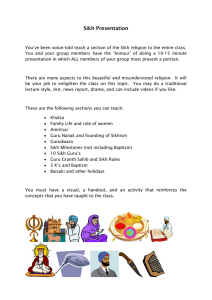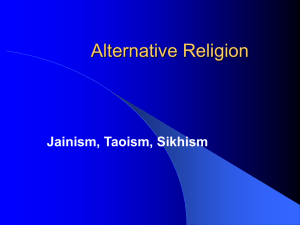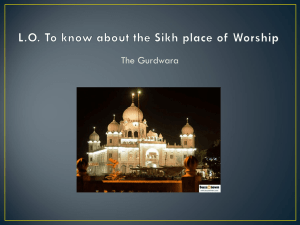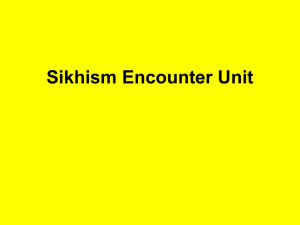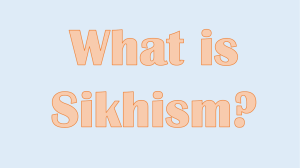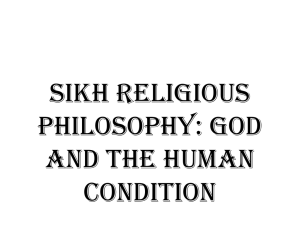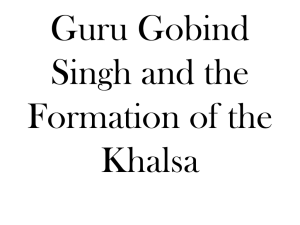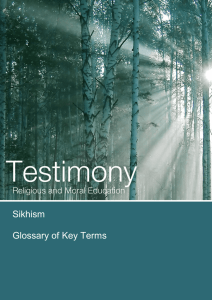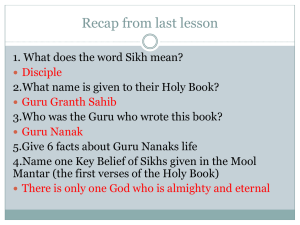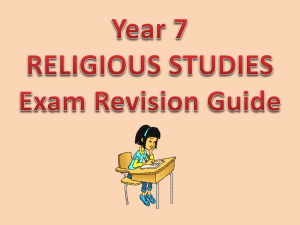Sikhism_ 2012
advertisement
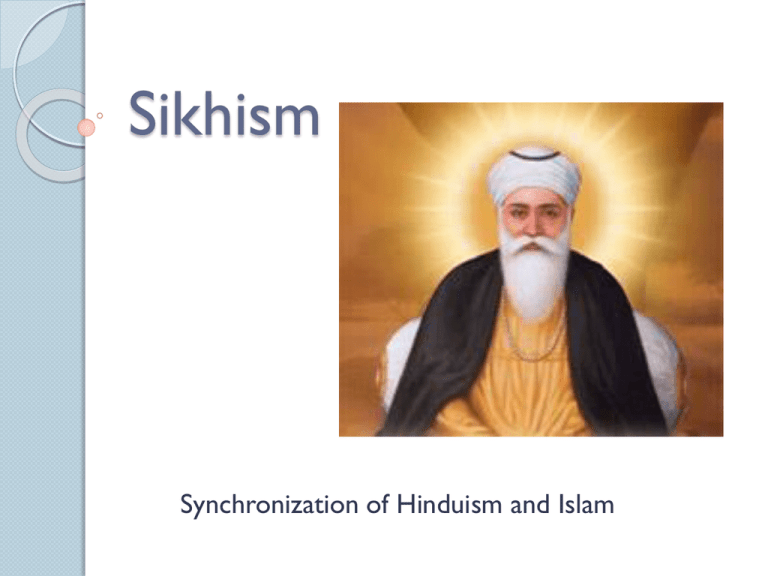
Sikhism Synchronization of Hinduism and Islam Basic Information Founded by Guru Nanak 15c Gu, darkness; ru, enlightenment; sikh, learner Guru: successors of Nanak (10), sacred text, God 23,000,000 Sikhs, Punjab, West India, 2,000,000 outside of India, (Recognizable by distinct turban) Attempts to reconcile Hinduism and Islam Kaur and Singh Monotheistic Salvation achieved by union with God and liberation from rebirth Mythic Guru Nanak ◦ Hindu of the warrior caste ◦ Decided after mediation and a mystical experience to follow God’s path ◦ Built a township called Kartarpur, abode of the Creator, first Sikh community (Panth) ◦ Body disappeared at death 10 Successor Gurus Founding of Khalsa ◦ An order in Sikhism founded by Guru Gobind Singh Installed the Adi Granth as the next Guru ◦ Based on the principle of loyalty Experiential Union with God ◦ God’s grace enables us to perceive God and to respond in meditation on God’s nature ◦ Meditation on the divine name of God and repetition of his name is the path to spiritual perfection ◦ Blissful and forever, beyond the cycle of death and rebirth Liberation from samsara ◦ Result of union with God Doctrinal Mool Mantra ◦ Beginning of the Adi Granth, a description of God Creator, preserver and destroyer Immanent, indwelling in creation ◦ Haumai Humans insisting that they can do things on their own; lust, anger, greed, attachment, and pride increase the distance to God ◦ Hukam The divine order of the universe; God’s immanence is perceivable; God imposes His will on humans through Hukam Ethical Four Prohibitions ◦ ◦ ◦ ◦ Prohibition against cutting of hair Eating improperly slaughtered meat Engaging in extramarital sexual relations Using tobacco Ritual Ceremony of Initiation into Khalsa ◦ 14 years old ◦ Possess the 5 K’s (Uncut hair, a comb, iron wrist guard, sword or knife, pair of shorts) ◦ Acceptance of the basic principles of Sikhism ◦ Sprinkling of nectar and recitation of the Mool Mantra ◦ Instruction on ethical requirements ◦ Share special cake Meditation on the divine Name Worship practices in the gurdwara ◦ Minarets, white paint ◦ Congregate to worship ◦ Evening, no particular day Bathing, singing, reading from scripture, eating cake ◦ Kitchen for community Social Panth ◦ Name given to the entire Sikh community Khalsa ◦ An order within Sikhism that requires a particular purity. ◦ Initiation into the order is ceremonial ritual Material Five K’s ◦ Uncut hair, knife or sword, comb, iron wrist guard, pair of shorts Food ◦ Special cake; wheat, ghee, sugar, water- symbolizes unity within the community Gurdwara ◦ Central structure of a Sikh community ◦ Holds the Adi Granth Adi Granth ◦ ◦ ◦ ◦ Compiled by the 5th Guru as the sacred scripture Installed as the next Guru by Guru Gobind Singh Holds a special seat in the Gurdwara Written in Punjabi
